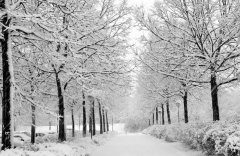 TAMPA – As another arctic cold front with frigid temperatures makes its way through the Midwest and into the Northeast and Southeast regions of the country, the Insurance Institute for Business & Home Safety (IBHS) provides severe winter weather guidance for home and business owners in those areas. Find out how you can reduce damage to your property from freezing weather by visiting http://www.disastersafety.org/freezing_weather.
TAMPA – As another arctic cold front with frigid temperatures makes its way through the Midwest and into the Northeast and Southeast regions of the country, the Insurance Institute for Business & Home Safety (IBHS) provides severe winter weather guidance for home and business owners in those areas. Find out how you can reduce damage to your property from freezing weather by visiting http://www.disastersafety.org/freezing_weather.
“Heavy snow and freezing temperatures can burst pipes, cause roofs to collapse and lead to interior fires as people use various alternative heating sources to stay warm,” said Julie Rochman, president and CEO of IBHS.
“There are steps you can take now to better withstand the effects of severe winter weather that will help avoid costly repairs and headaches later.”
IBHS FREEZING WEATHER GUIDANCE
Install Weather Stripping and Seals
One thing you can do now to prevent freezing temperatures from entering your home or business is to install weather stripping and seals. This offers two major benefits – it will keep severe winter weather out of your home or business and seal your property shut, as well as greatly increase energy efficiency by limiting drafts and reducing the amount of cold air that enters. Inspect the following areas of your home or business for leaks to determine possible areas to seal.
• Windows and doors
• Vents and fans
• Plumbing
• Air conditioners
• Electrical and gas lines
• Mail chutes
Learn how to install weather stripping and caulking at http://www.disastersafety.org/disastersafety/installing-weather-stripping-seals.
Stay Safe and Warm
Alternative heating sources can help you stay warm during the cold weather, especially during power outages, which often occur due to heavy snow and ice, as well as high winds during winter storms. It’s important to prepare a plan now before a possible outage. Check IBHS’ guidance before selecting, installing or using an alternative heating source such as a wood stove, space heater or fireplace: http://www.disastersafety.org/wp-content/uploads/alternative-heating.pdf.
Prevent Frozen Pipes
Frozen pipes are one of the biggest risks when the temperature drops, which can result in more than $5,000 in water damage, according to IBHS research. Follow the recommendations below to prevent costly water damage.
• Provide a reliable back-up power source to ensure continuous power to the building.
• Insulate all attic penetrations where cold air can get inside the building.
• Ensure proper seals on all doors and windows.
• Seal all wall cracks and penetrations, including domestic and fire protection lines, electrical conduit, and other utility service lines.
• Install insulation and/or heat trace tape with a reliable power source on wet sprinkler system piping. This includes main lines coming up from underground, passing through a wall, as well as sprinkler branch lines.
• Place a monitored automatic excess flow switch on the main incoming domestic water line to provide early detection of a broken pipe or valve when the building is unoccupied.
IBHS’ Freezing Weather page on DisasterSafety.org provides guidance on how to protect your home against other winter weather-related hazards such as roof collapse and ice dams due to large amounts of snow and ice.
Follow IBHS on Twitter at @DisasterSafety and on Facebook for how-to projects to make your home more resistant to a variety of natural hazards.



